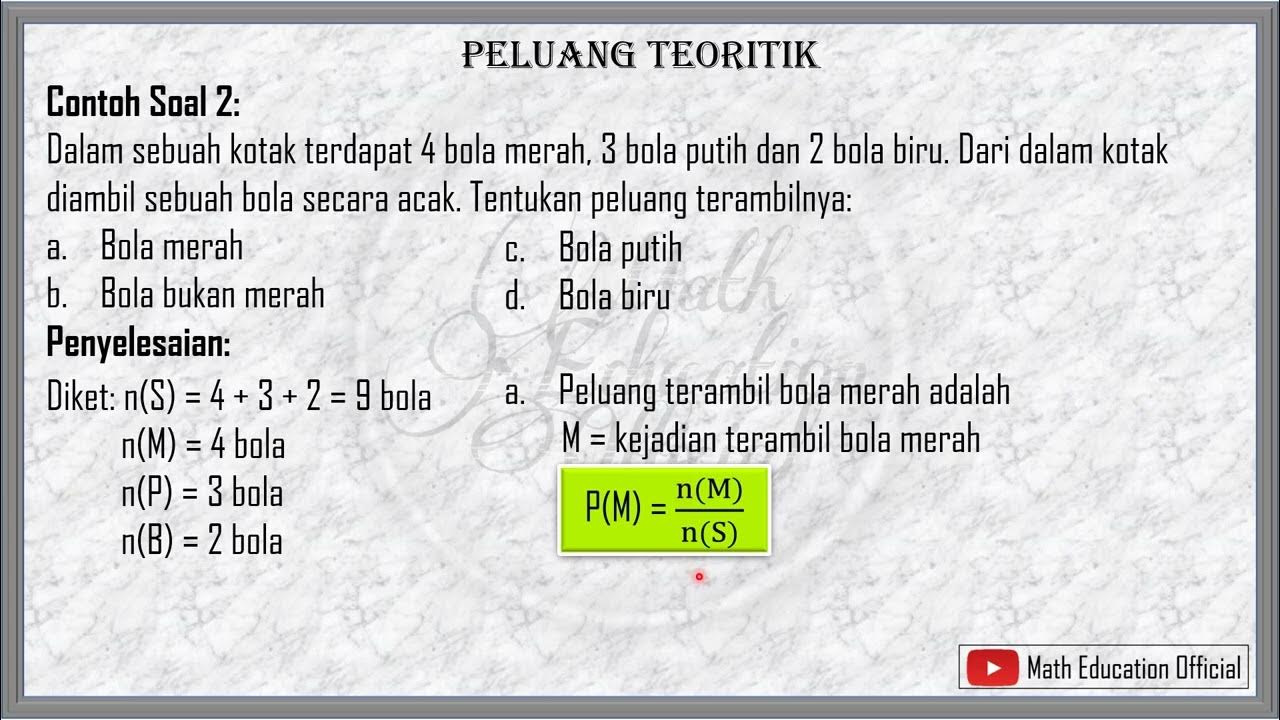Distribusi Binomial • Part 12: Contoh Soal Distribusi Peluang Binomial (3)
Summary
TLDRIn this video, Jendela Sains explains how to solve problems involving binomial distribution with a focus on drawing balls from a box containing red and yellow balls. Two example problems are presented: calculating the probability of drawing one red ball five times in 8 trials, and determining the likelihood of drawing two yellow balls four times. The video provides step-by-step instructions on calculating the probabilities for both scenarios using binomial distribution, including explanations of key terms like success, failure, and how to use the binomial formula effectively. Viewers are encouraged to explore a full playlist for further learning.
Takeaways
- 😀 The video explains the concept of binomial distribution, specifically in the context of drawing balls from a box with replacement.
- 😀 The problem involves a box containing 6 red balls and 4 yellow balls, from which two balls are drawn randomly, with replacement, for 8 trials.
- 😀 The goal of the first problem (A) is to determine the probability of drawing exactly one red ball five times out of the eight trials.
- 😀 In order to solve the problem, the concept of success is defined as drawing one red and one yellow ball in each trial.
- 😀 The probability of drawing one red and one yellow ball in a single trial is calculated as 8/15.
- 😀 The complement probability, or failure, occurs when the outcome is not exactly one red and one yellow ball, and is calculated as 7/15.
- 😀 The binomial distribution formula is then applied to calculate the probability of getting exactly five successes (one red and one yellow ball) out of eight trials, resulting in a probability of 0.2456.
- 😀 In the second part (B), the problem is about finding the probability of drawing exactly two yellow balls four times out of eight trials.
- 😀 For this second problem, the success is defined as drawing two yellow balls in a trial, and the probability of success is calculated as 2/15.
- 😀 Using the same binomial distribution formula, the probability of drawing two yellow balls exactly four times out of eight trials is calculated as 0.0125.
- 😀 The video emphasizes the importance of using the binomial distribution to model repeated trials with two possible outcomes (success or failure).
Q & A
What is the main topic of the video?
-The video explains how to calculate probabilities using binomial distribution, specifically in the context of drawing red and yellow balls from a box over multiple trials.
What is the setup of the problem discussed in the video?
-The problem involves a box containing six red balls and four yellow balls. Two balls are drawn at random, replaced, and the process is repeated eight times.
What does 'success' mean in the context of the first problem?
-In the first problem, 'success' means drawing one red ball and one yellow ball in each trial.
How is the probability of success (p) calculated in the first problem?
-The probability of success is calculated as the ratio of successful outcomes (drawing one red and one yellow ball) to the total possible outcomes. It is found to be 8/15.
What is the probability of failure (q) in the first problem?
-The probability of failure (q) is calculated as 1 minus the probability of success. It is found to be 7/15.
How is the binomial distribution formula applied in the first problem?
-The binomial distribution formula is applied to calculate the probability of drawing exactly 5 successes (one red and one yellow ball) in 8 trials. The formula used is: P(X = 5) = 8C5 * (8/15)^5 * (7/15)^3.
What is the result of the calculation in the first problem?
-The result of the calculation is approximately 0.2456, which is the probability of drawing exactly 5 successes (one red and one yellow ball) in 8 trials.
What changes in the second problem compared to the first?
-In the second problem, the definition of success changes to drawing two yellow balls instead of one red and one yellow ball.
How is the probability of success (p) calculated in the second problem?
-The probability of success is calculated as the ratio of successful outcomes (drawing two yellow balls) to the total possible outcomes. It is found to be 2/15.
What is the probability of failure (q) in the second problem?
-The probability of failure (q) in the second problem is 1 minus the probability of success, which is 13/15.
How is the binomial distribution formula applied in the second problem?
-The binomial distribution formula is used to calculate the probability of drawing exactly 4 successes (two yellow balls) in 8 trials. The formula used is: P(X = 4) = 8C4 * (2/15)^4 * (13/15)^4.
What is the result of the calculation in the second problem?
-The result of the calculation is approximately 0.0125, which is the probability of drawing exactly 4 successes (two yellow balls) in 8 trials.
Outlines

This section is available to paid users only. Please upgrade to access this part.
Upgrade NowMindmap

This section is available to paid users only. Please upgrade to access this part.
Upgrade NowKeywords

This section is available to paid users only. Please upgrade to access this part.
Upgrade NowHighlights

This section is available to paid users only. Please upgrade to access this part.
Upgrade NowTranscripts

This section is available to paid users only. Please upgrade to access this part.
Upgrade NowBrowse More Related Video

Distribusi Binomial • Part 6: Contoh Soal Distribusi Peluang Variabel Acak Diskrit (3)

KONSEP, SOAL, DAN PEMBAHASAN MATERI DISTRIBUSI BINOMIAL![MATEMATIKA PEMINATAN KELAS 12]

Peluang Teoritik

Pembahasan Contoh Soal Distribusi Binomial - Penjelasan Singkat dan Jelas

Matriks Matematika Kelas 11 • Part 23: Menyelesaikan SPLTV dengan Metode Determinan Matriks

Pembahasan materi PELUANG dasar! Sampai semua paham, ngerti, understand! #MatematikAsik
5.0 / 5 (0 votes)